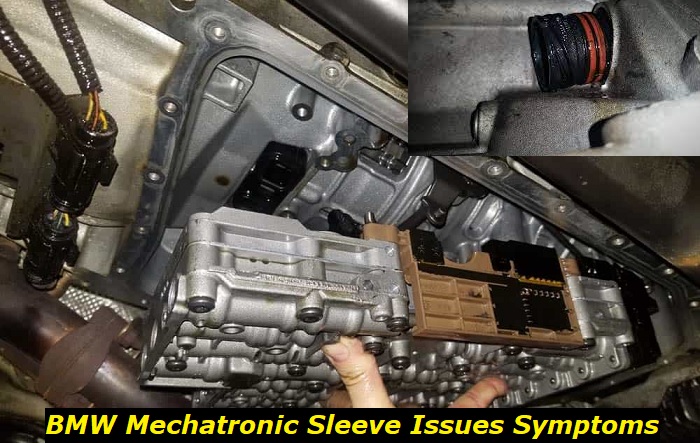Owning a Bimmer affords you a plethora of cool features and benefits. But it also comes with a few terminologies and technologies that can prove a complication over time. Among the things your BMW has is the mechatronic unit, which comprises several small parts. A malfunction of the mechatronic unit will cause you a lot of headaches and distress.
Transmission issues highlights
- Level of importance:Medium
- Reasons:TCM problems, low fluid, shifter issues
- Needed expertise:High
- Needed tools:Professional tools set
- Time taken:3-8 hours
- Can you drive? Yes, if possible
- Possible issues:Torque converter damage, overheating, TCM damage.

Overview of mechatronic unit
In the early 2000s, the ZF 6HP transmission was launched. Its production continued until 2014. The transmission was iconic and transformative in the automatic transmission field, where drivers were given a chance to enjoy their cars more. Besides BMW, the transmission was used in Ford, GM, Audi, and Mercedes. In the BMW house, the ZF 6HP, which exhibited a mechatronic unit, was installed in E63 6 series, E9x 3 series, 5 series, 7 series, and Z4, among others.
Mechatronics is a term commonly used in the relatively modern Bimmer circles. The term refers to an electronic valve body that controls the functions of your car's automatic transmission. Failure or malfunction of this component will make the car's transmission act abnormally by exhibiting improper gear shifting or failing to shift at all.
Mechatronics in your BMW comprises a mechanical part and an electronic one. Numerous sensors, valves, solenoids, and sleeves ensure the unit performs optimally. For complete integration with the transmission of the car, the mechatronic unit accommodates transmission oil hence making it part and parcel of the transmission.
What is a mechatronic sleeve?
The mechatronic sleeve is one of the mechanical parts found in the mechatronic unit. The parts allow the safe passage of oil between the transmission body and the mechatronic unit or, in simpler words, the valve body. It also ensures the smooth movement of transmission fluid within the unit and the overall optimal performance of the transmission. The sleeve has three holes with several o-rings to ensure that transmission oil does not leak.
The mechatronic sleeve ages like the rest of the car. It is common to find that a relatively old Bimmer developing a mechatronic sleeve issue more than a relatively new car. The sleeve usually cracks, and this causes transmission fluid leakage and a whole list of other problems. If not addressed on time, the mechatronic sleeve failure can lead to more serious problems, such as damage to the gearbox.
Symptoms of a bad mechatronic sleeve
A problem with the mechatronic sleeve means a problem with the mechatronic unit. However, specific symptoms can help you pinpoint the problem to the sleeve. Here are the symptoms;
1) Harsh shift from second down to first gear
This is an issue reported by many drivers, and when they took their Bimmers to the mechanics, the issue was discovered to be a cracked mechatronic sleeve. The change in gears might also feel a bit jerky, or it can be a strong bump or lurch forward when you are downshifting. This will be especially the case when you are coming to a stop.
2) Transmission fluid leaking
The other common symptom to look out for is fluid leakage from the electrical connector on the pan's side. At first, the leak will be minimal, but if you ignore the characteristics, the leakage will be much more.
3) A transmission warning light
A warning light will pop up on the dashboard, showing an outline of the transmission. In most instances, the warning light is accompanied by the above symptoms.
4) Trouble code
When you connect the vehicle to the OBD II scanner, a code relating to the mechatronic will be recorded. Some codes pointing toward a faulty mechatronic sleeve or unit include 4F8F, 4F84, and 4E87.
How to fix the mechatronic sleeve problem
Problems arising from a faulty mechatronic sleeve are solved mostly by replacing the sleeve. The sleeve cannot be repaired, and it cannot be substituted with anything else. You will therefore need to take the car to a qualified BMW mechanic and resolve the problem for you.
- DIYers have also succeeded in replacing the mechatronic sleeve on their BMWs. To successfully replace the sleeve, you must know some basic facts about the process and the cost.
- First, you need to know that the transmission oil should be replaced every time you drain it. It is not cheap, and the recommended fluid is ZF trans fluid. You will need around 8 liters.
- The transmission fluid pan is plastic and is designed to be replaced every time you are replacing the trans fluid. The plastic pan and the trans-fluid filter come as a unit. This pan and the affixed filter will be among the parts to buy when you plan to replace a mechatronic sleeve.
- The mechatronic sleeve cracks with age. However, if you replace the transmission fluid every 50,000 miles, you may find yourself escaping problems associated with this sleeve. This is because, with every trans fluid change, the filter must be replaced.
Here are the steps to follow:
- Lift the car to allow you clear and uninterrupted access to the car's undercarriage. Remove the plastic panels covering the transmission. You may also need to remove the panels under the engine if you need more room.
- Use a 10mm hex bolt to unlock the pan's drain bolt. However, you will need first to release the fill plug on the oil pan's side. The fill plug is loosened using an 8mm hex bolt, but accessing it requires a turnkey. Of course, have a draining container to avoid messing your working space with transmission fluid.
- Remove the various brackets holding the transmission fluid pan and also the heat brackets. This allows you to remove the pan without much hindrances.
- The next step is to remove the plug adapter or the electronic connector at the pan's side. Turn the adapter counterclockwise until an audible click is heard, and the whole adapter should slide out as you turn it. The turning of the adapter is made easy by the grooved ring around it. You might need a long skinny screwdriver to pry the adapter out.
- For the modern 5 series Bimmer and the like with an electronic shifter, you will need to loosen the mechanism on the side of the fluid pan. Unlocking the mechanism allows for the pan to come off with ease.
- After removing the transmission fluid pan, it is time to remove all the t40 bolts holding the mechatronic unit in place.
- Once the mechatronic unit is detached from the transmission, you should see the mechatronic sleeve and the solenoid valves. Detach the sleeve and inspect it for cracks or any other kind of damage. For jerky downshifting of the car, you will likely find a crack on the sleeve. Place the new sleeve on the transmission body.
- If you are experiencing any other shifting problems, you should inspect the solenoid valves. ZF sells a solenoid valve kit with all the necessary valves and sleeves and an instruction manual for easy assembly.
- On the transmission body, you will see four valves that are also culprits when the car has shifting problems. Some people refer to the four valves as sleeves. Replacing these is pretty easy since you only need an angle pick to pry them out. Two valves are of the same length, the third is of medium length, and the fourth is the longest.
- Once everything is good, reassemble the mechatronic unit back onto the transmission. Ensure the gear selector on the transmission aligns properly with the notch on the mechatronic unit. After fixing the unit, confirm that the gear selector aligns properly; otherwise, you will not be able to change gear.
- It is important to note that when reassembling the mechatronic unit, all the t40 bolts should be tightened using hand, not power tools. There is a specific sequence of fastening the bolts.
- Fix the pan and filter once the adapter and the fill bolt are securely in place. Don't forget to secure all the brackets in place.
- It is now time to finally fill the transmission with new ZF fluid or any fluid recommended by your local Bimmer dealership. You will need to pump the fluid into the transmission. Usually, about four liters will go into the transmission, and then it will start overflowing via the fill plug.
- Start the engine and shit the gear shifter through the gears. Shift from park to reverse and so on, and between each gear, wait for about five seconds. This allows fluid flow throughout the transmission and the cooler lines.
- The next step is to use an approved Bimmer scanning tool to help you monitor the temperature of the fluid. The recommended temperature should be around 40 degrees. Continue pumping the fluid into the transmission until a steady fluid flow comes out of the fill hole. You should be able to put another four liters of fluid into the transmission while the engine is running.
Conclusion
The mechatronic sleeve is a simple part inside the somewhat complex mechatronic unit. Any damage to the sleeve will cause several issues, among them jerky downshifting. With the instructions on how to fix the problem, an enthusiastic and dedicated DIYer should have an easy time fixing the problem.
About the authors
The CarAraC research team is composed of seasoned auto mechanics and automotive industry professionals, including individuals with advanced degrees and certifications in their field. Our team members boast prestigious credentials, reflecting their extensive knowledge and skills. These qualifications include: IMI: Institute of the Motor Industry, ASE-Certified Master Automobile Technicians; Coventry University, Graduate of MA in Automotive Journalism; Politecnico di Torino, Italy, MS Automotive Engineering; Ss. Cyril and Methodius University in Skopje, Mechanical University in Skopje; TOC Automotive College; DHA Suffa University, Department of Mechanical Engineering






Add comment